Chinese Architecture (Part 1)
1/76
There's no tags or description
Looks like no tags are added yet.
Name | Mastery | Learn | Test | Matching | Spaced |
|---|
No study sessions yet.
77 Terms
Palaces and Temples
The chief building types in Chinese architecture, exemplified by structures like the Forbidden City and Temple of Heaven.
Wood Frame Construction
A primary construction system used in traditional Chinese architecture.
Bilateral Symmetry
A design principle emphasizing balanced and mirrored layouts in buildings.
Hierarchy of Buildings
The arrangement of structures based on their significance and placement within a complex.
Cosmological Concepts
Ideas such as feng shui that influence architectural design and placement.
Geographical Influence
The impact of China's diverse geography on architectural styles and materials.
Northern China
Characterized by thicker walls and courtyards to withstand colder climates.
Southern China
Utilizes lighter materials like wood and bamboo, with elevated floors to avoid flooding.
Mountain Areas
Architecture adapted to rugged terrains, often featuring tiered or stilted structures.
Geological Influence
The availability of natural resources that determined construction materials in different regions.
Rammed Earth
A construction technique using compacted natural materials for foundations and walls.
Climatic Influence
How regional climates dictate architectural solutions for comfort.
Kang
An elevated heated platform developed in Northern China to retain warmth during cold winters.
Historical Influence
The evolution of Chinese architecture through various dynasties, each contributing unique styles.
Han Dynasty
The era that introduced typical Chinese architectural elements like courtyards and symmetry.
Tang Dynasty
Known as a golden age for architecture, marked by the construction of Buddhist temples and pagodas.
Song Dynasty
Innovations in construction techniques, allowing for larger buildings with broader roofs.
Ming Dynasty
Recognized for grand palatial architecture emphasizing balance and symbolism.
Qing Dynasty
A period of refinement in traditional elements and increased Western influence.
Confucianism
A philosophy influencing architecture through hierarchy and harmony, evident in the layout of palaces and temples.
Buddhism
Introduced pagodas and monasteries, with architecture symbolizing the connection between heaven and earth.
Taoism/Daoism
Advocated for harmony with nature, reflected in gardens and pavilions that blend with the landscape.
Ancient Structures
Key types include palaces, temples, tombs, pagodas, and city walls.
Forbidden City
A grand palace complex designed with strict adherence to hierarchical and symbolic principles.
Temple of Heaven
An imperial sacrificial building complex symbolizing the relationship between earth and heaven.
Tombs and Mausoleums
Large structures reflecting beliefs in the afterlife, such as the Mausoleum of the first Qin Emperor.
Pagodas
Multi-storied towers introduced through Buddhism, serving as memorials or to hold relics.
Siheyuan
Traditional residential compounds designed around a central courtyard, common among wealthy families.
Great Wall of China
A monumental defense structure symbolizing protection and cultural preservation.
Dougong
An interlocking bracket system used in traditional construction for structural and decorative purposes.
Jian
The basic measure in construction, marking a standard unit of space.
Hierarchy and Symbolism
Distinct characteristics defining ancient Chinese architecture.
Curved Roofs and Eaves
A common architectural feature in traditional Chinese buildings.
Color Symbolism
The significance of colors in architecture, such as yellow for emperors and red for fire.
Ornamental Details
Intricate carvings and decorations on beams and ceilings, often featuring mythical creatures.
Feng Shui
The practice of arranging buildings to promote positive energy flow and harmony with nature.
Modular Design
A construction principle allowing flexibility and ease of expansion in buildings.
Blending with Nature
The architectural goal of harmonizing structures with the natural environment, especially in gardens.
Kaohsiung Confucius Temple
Taiwan-Multi-tiered roofs, beautifully designed archways and magnificent temples and residences.
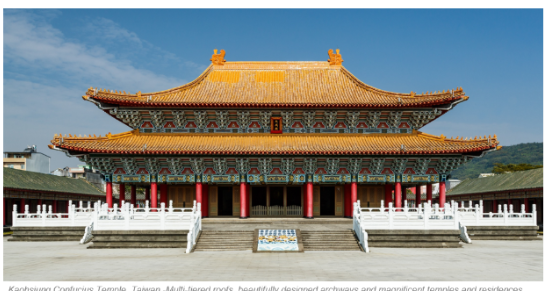
Hall of Guanyin
is the most important annex halls in Chinese Buddhist temples and mainly for enshrining Guanyin.
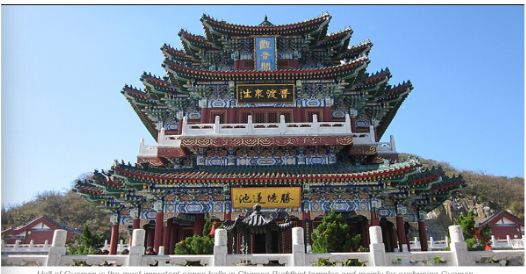
Mount Laojun
in Luoyin, Henan Province, China is a sacred site for Taoists.
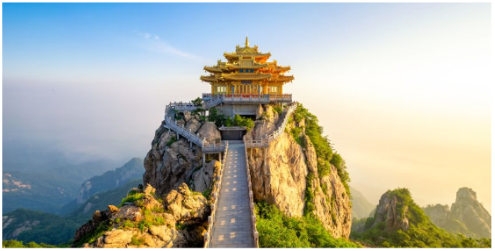
Confucianism
The least noisy, colorful, and lively of all Chinese temples.
Courtyards are usually filled with stelae (stone tablets) dedicated to various local scholars.
Buddhism
Usually contain the same combination of fairly recognizable important deities.
Other signs are pagodas (built to house relics and sutras), the columns which are red in Buddhist temples and black in Taoist temples.
Taoist
Most colorful and snazzy
Main gates are painted with fierce-looking mythical heroes to scare off evil spirits.
The halls can contain any number of different deities, the many-armed Guan Yin among them.
Palaces
Temples and monasteries
Tombs and Mausoleums
Pagodas
Residential courtyards
City Walls and fortification
ANCIENT STRUCTURES
Palaces
these grand complexes, like the Forbidden City, were designed with strict adherence to hierarchical and symbolic principles. Symmetry, central axes, and the use of open courtyards were essential.
Hall of Supreme Harmony
, emperor’s throne room; also where he met daily his officials.
Palace of Heavenly Purity
the residence of the son of heaven and the conceptual center of the empire.
Beijing, China. (Built by emperor Zhu Di, the best preserved imperial palace in China.)
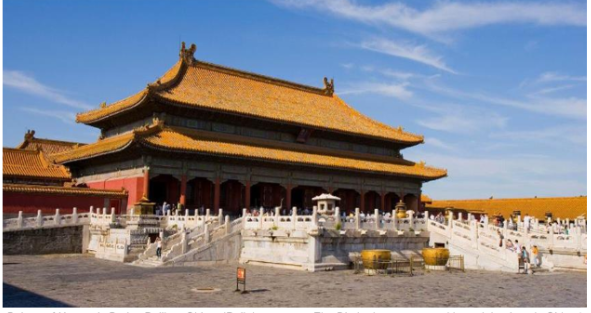
Mingtang
Bright hall
A ritual structure that serves as the symbolic center of imperial power.
Designated as the intersection of heaven (circle) and earth (square), oriented around the four cardinal directions.
Temples and Monasteries
Religious buildings, such as Buddhist temples, Daoist temples, and Confucian academies, were built with spiritual significance. Struuctures like pagodas (Big Wild Goose Pagoda) were often part of temple complexes.
Biyong
jade ring moat
Temple of Heaven
In its overall layout and that of its individual buildings, it symbolizes the relationship between earth and heaven and also the special role played by the emperors within that relationship.
It is the most complete existing imperial sacrificial building complex in China and the world’s largest existing building complex for offering sacrifice to heaven. (UNESCO)
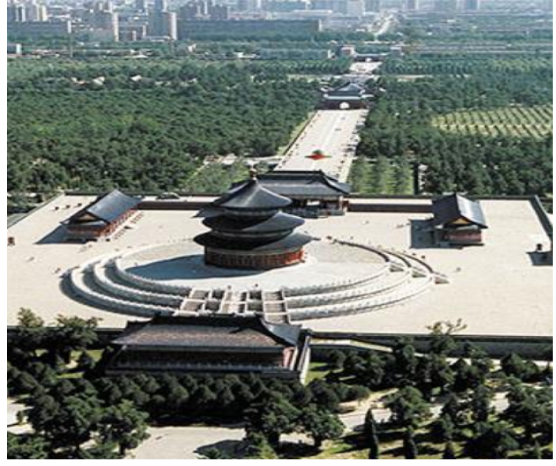
Tombs and Mausoleums
The most famous of these is the Mausoleum of the first Qin Emperor, which includes the Terracotta Army. Ancient Chinese tombs were typically large, mound-like structures reflecting the belief in the afterlife.
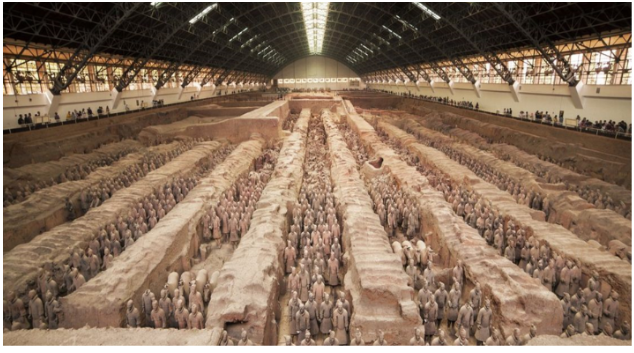
Pagodas
Tall, multi-storied towers introduced from India through Buddhism. Examples: Songyue Pagoda (Henan) and Iron Pagoda (Kaifeng)
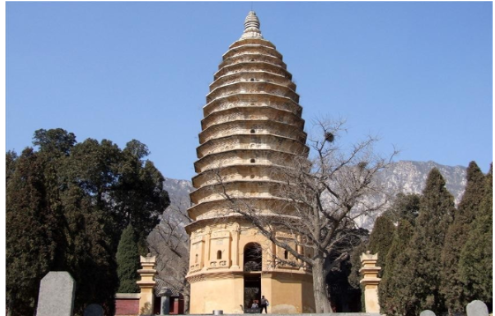
Ta
A Chinese pagoda
Pagoda, Buddhist temple, square or polygonal in plan, with roofs projecting from each storey; erected as a memorial or to hold relics (derived from the Indian stupa)
Residential Courtyards (Siheyuan)
These were traditional residential compounds designed around a central courtyard, prevalent among wealthy families and officials. They are a hallmark of Beijing’s hutongs.
Fogong Pagoda
200 foot-high tower built entirely out of wood
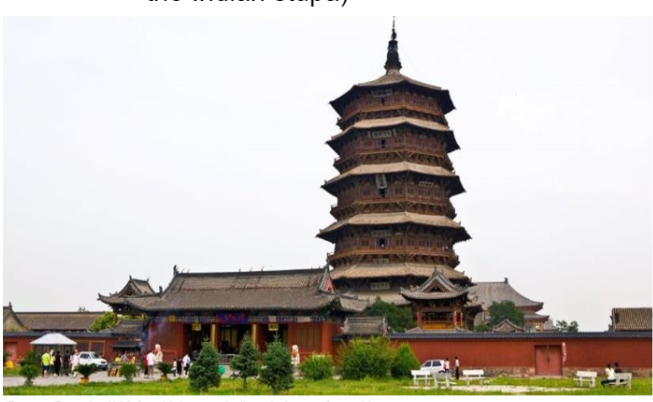
City Walls and Fortifications
The Great Wall of China, spanning thousands of miles, and city walls (like those of Xi’an) were built as defense structures, often using rammed earth and brick.
Great Wall of China
Has an incomparable symbolic significance in the history of China
Its purpose was to protect China from outside aggression, but also to preserve its culture from the customs of foreign barbarians.
Also served as means of communication.
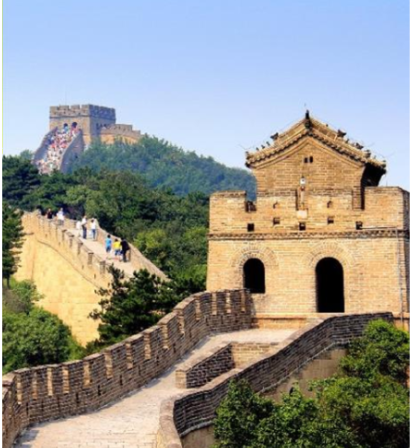
Pailou
monumental gateway to a palace, tomb, or sacred place.
Zhonglou
bell tower or pavilion at the right side of a city gate, palace entrance, or forecourt of a temple.
Gulou
left side counterpart of a zhonglou.
Particular Methods for Construction
Timber Frame Construction (Post and Beam)
Rammed Earth and Brick Walls
Roofing System - Curved Roofs
Use of Symmetry
Courtyards Designs
Dougong
Interlocking bracket system used in traditional Chinese construction to support roof beams.
Has both structural and decorative purpose
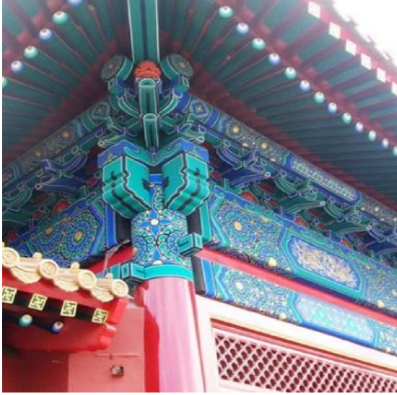
Jian
The basic measure in construction
Standard unit of space marked by adjacent frame supports
Hierarchy and Symbolism
Curved Roofs and Eaves
Axial Layout
Color Symbolism
Use of Wood
Characteristics
Several distinct characteristics define ancient Chinese architecture:
Chiwen
a mythical fish often placed at the roof’s edge, was believed to ward off fires.
yellow-glazed tile
was exclusively reserved for the emperor’s use in buildings like the Forbidden City.
Stone Lions (Shishi)
Pairs of stone lions were placed in front of important buildings to symbolize strength and protection.
These guardian lions are iconic and widely replicated.
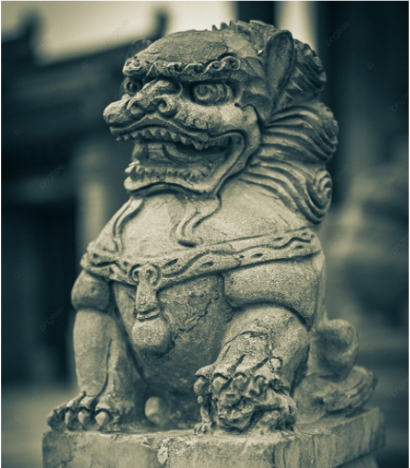
Chinese calligraphy
Buildings often featured plaques and inscriptions in Chinese calligraphy, especially in temples and palaces, adding a layer of cultural and historical significance.
Feng Shui
Buildings were often aligned along cardinal directions to ensure good energy flow.
Modular Design
The buildings were often composed of modular units, allowing flexibility and ease of expansion of reconstruction.
Blending with Nature
Ancient Chinese architecture often sought to harmonize with the natural environment, especially in garden designs.
Feng Shui
“Wind water”
Arranging architectural elements so that they are in harmony with nature.
Goal: to promote the optimal flow of positive energy (chi’i) within the building
Most buildings face south or southeast to take advantage of prevailing winds and sunshine.
Palaces and temples are the chief building type; Forbidden City, Temple of Heaven.
Hierarchy of Buildings
Bilateral Symmetry
Symbolism of colours
Cosmological concepts
QUICK RECAP: CHINESE